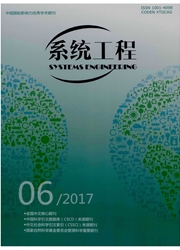

 中文摘要:
中文摘要:
CCR模型中,决策单元的效率值为输出的加权平均与输入的加权平均比值的最大值,而本文则认为所有可能的输出的加权平均与输入的加权平均比值都是可能的效率值,因此决策单元的效率值为一区间。基于交叉效率方法,本文得出了决策单元的区间效率值并进行了排序。所得出的区间效率值不仅比传统的点效率值更加全面地反映决策单元的表现,而且由于交叉效率方法的自互评本质,它比已有的区间效率构建方法更加合理、可信。文末给出了一个算例。
 英文摘要:
英文摘要:
In CCR model, the maximum of relative ratio of weighted sum of outputs to that of inputs is regarded as the efficiency, but we think that all the possible ratio of weighted sum of outputs to that of inputs are assumed as the possible efficiencies, then the efficiency can be an interval. We formulate a CCR model with an interval efficiency which consists of efficiencies obtained from the cross efficiency, then all the DMUs are ranked by an interval ranking approach. Interval efficiencies obtained from our approach measures the performances of DMUs not only more comprehensively than traditional CCR efficiency, but also more reasonably and credibly than the existing interval efficiencies constructed by the other approaches, thanks to the nature of the essential self-evaluation and peer-evaluation of cross efficiency approach. In the end, an empirical example is given to test its validaty.
 同期刊论文项目
同期刊论文项目
 同项目期刊论文
同项目期刊论文
 期刊信息
期刊信息
